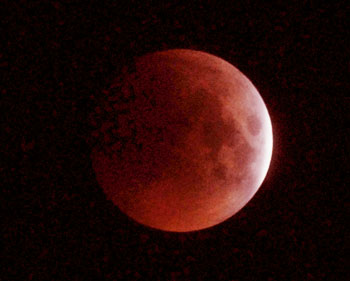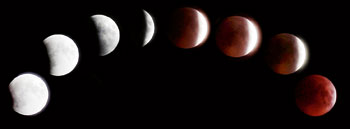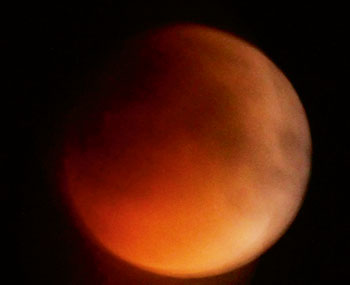Cloudy skies prevented most of us from photographing the much awaited total lunar eclipse which took place on Poson poya day. Colombo was clear right up to just before totality, after which it clouded over. A few lucky photographers got a view of totality through holes in the cloud cover.
 |
| Some of the few spectacular pictures (including top combo picture) taken of the Total Lunar Eclipse, this Poson full Moon Poya day by Times photographer Sanka Vidanagama |
 |
 |
| Shirani and Trevine Jayasekara were lucky to take this image from near Peradeniya few minutes after totality. It shows the dark red appearance of the Moon during totality. |
I travelled out of Colombo with a small group of young astronomy enthusiasts hoping to get to clear skies. We originally planned to go up to Dambulla, but after looking at satellite images, we decided to drive down to Embilipitiya.
As we approached Embilipitiya, waiting for a break in the cloud cover, we suddenly saw the rising Moon, directly in front of us. The illusion of the large Moon just around the tree level gave us hope for clear skies.
After dinner, we set up close to the Chandrika wewa. However, there was a thin layer of high cirrus cloud which covered the Moon and made it difficult to photograph. We saw the start of the totality for about 20 minutes, but that too was through thin cloud.
The only clear view was on our way back as the Moon was leaving the umbra. The satellite image of Sri Lanka under the influence of the South West monsoon illustrates the disappointment that most of us had who tried to view this eclipse.
During totality, the Moon is only illuminated by sunlight refracting through the Earth’s atmosphere. Since the blue light is scattered down to make the sky blue, the remaining light which reaches the Moon is red or orange.
The appearance during totality depends on dust and clouds in the Earth’s atmosphere. There were suggestions that that appearance would be darker due to last week’s erupting volcano in Chile.
It was one of the longest lunar eclipses with totality lasting for just over 100 minutes, the maximum possible duration being 107 minutes.
The next total eclipse of the Moon is on December 10, 2011, with totality lasting only 50 minutes.
Hopefully we will have better weather then. |




